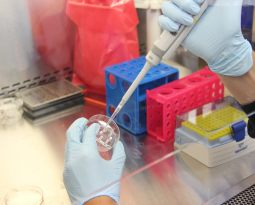Indiana Patent of the Month – February 2023
The FDA has stringent regulations requiring manufacturers to track certain medical devices throughout their entire distribution chain. This facilitates recalls, ensuring all devices are located in the case they may pose a risk due to any fault in manufacturing. In the case of implantable devices, a removable identifier tag must be included with each implant. This adds costs and time to the manufacture of devices, requiring additional tools, materials and steps. This is especially challenging when the implant is tiny – like a bone screw.
Nexxt Spine LLC, a medical device manufacturer, has developed an innovative solution to the challenges posed by FDA regulations on medical device tracking. Rather than producing a removable tag for each bone screw (and other implants), the solution offers a way to manufacture the bone screw with the frangible tracking tag built in.
Nexxt Spine has patented the design for a bone screw with an identifying tag integrally formed in its surface. Designing this screw was not without challenge as every surface of the bone screw performs an important function and is subject to stringent dimensional controls.
To overcome this challenge, Nexxt Spine designed the tag body to be a separate component from the screw body, but still integrated into the screw’s functionality. The tag body is made from the same material as the screw body and has a tapered end that is configured to fit within a recess formed in the screw head. This allows the tag body to be securely attached to the screw body without interfering with the screw’s function.
The tag body also includes a surface that is configured to display traceability information, such as a unique device identifier (UDI) code. The tag body can be easily removed from the screw body using a surgical instrument after implantation, which allows for the traceability information to be accessed and recorded for tracking purposes.
Nexxt Spine’s innovative solution to the challenge of displaying traceability information on small implants like bone screws is a significant advancement in medical device manufacturing. By integrating the tag body into the screw’s functionality, Nexxt Spine LLC has created a solution that meets FDA requirements while minimizing the impact on the manufacturing process and the implant’s function. This is a great example of how innovative design can solve complex problems and advance medical technology.
Are you developing new technology for an existing application? Did you know your development work could be eligible for the R&D Tax Credit and you can receive up to 14% back on your expenses? Even if your development isn’t successful your work may still qualify for R&D credits (i.e. you don’t need to have a patent to qualify). To find out more, please contact a Swanson Reed R&D Specialist today or check out our free online eligibility test.
Who We Are:
Swanson Reed is one of the U.S.’ largest Specialist R&D tax advisory firms. We manage all facets of the R&D tax credit program, from claim preparation and audit compliance to claim disputes.
Swanson Reed regularly hosts free webinars and provides free IRS CE and CPE credits for CPAs. For more information please visit us at www.swansonreed.com/webinars or contact your usual Swanson Reed representative.

















